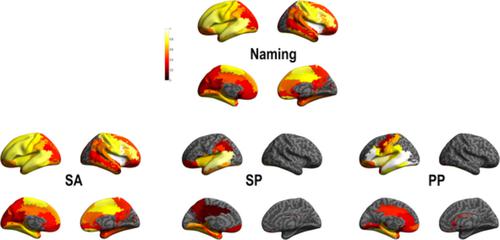当前位置:
X-MOL 学术
›
Hum. Brain Mapp.
›
论文详情
Our official English website, www.x-mol.net, welcomes your feedback! (Note: you will need to create a separate account there.)
Probabilistic mapping of language networks from high frequency activity induced by direct electrical stimulation.
Human Brain Mapping ( IF 4.8 ) Pub Date : 2020-07-22 , DOI: 10.1002/hbm.25112 Marcela Perrone-Bertolotti 1, 2 , Sarah Alexandre 3 , Anne-Sophie Jobb 3, 4, 5 , Luca De Palma 3 , Monica Baciu 1, 2 , Marie-Pierre Mairesse 3 , Dominique Hoffmann 6 , Lorella Minotti 3, 4, 5 , Philippe Kahane 3, 4, 5 , Olivier David 4, 5
Human Brain Mapping ( IF 4.8 ) Pub Date : 2020-07-22 , DOI: 10.1002/hbm.25112 Marcela Perrone-Bertolotti 1, 2 , Sarah Alexandre 3 , Anne-Sophie Jobb 3, 4, 5 , Luca De Palma 3 , Monica Baciu 1, 2 , Marie-Pierre Mairesse 3 , Dominique Hoffmann 6 , Lorella Minotti 3, 4, 5 , Philippe Kahane 3, 4, 5 , Olivier David 4, 5
Affiliation

|
Direct electrical stimulation (DES) at 50 Hz is used as a gold standard to map cognitive functions but little is known about its ability to map large‐scale networks and specific subnetwork. In the present study, we aim to propose a new methodological approach to evaluate the specific hypothesis suggesting that language errors/dysfunction induced by DES are the result of large‐scale network modification rather than of a single cortical region, which explains that similar language symptoms may be observed after stimulation of different cortical regions belonging to this network. We retrospectively examined 29 patients suffering from focal drug‐resistant epilepsy who benefitted from stereo‐electroencephalographic (SEEG) exploration and exhibited language symptoms during a naming task following 50 Hz DES. We assessed the large‐scale language network correlated with behavioral DES‐induced responses (naming errors) by quantifying DES‐induced changes in high frequency activity (HFA, 70–150 Hz) outside the stimulated cortical region. We developed a probabilistic approach to report the spatial pattern of HFA modulations during DES‐induced language errors. Similarly, we mapped the pattern of after‐discharges (3–35 Hz) occurring after DES. HFA modulations concurrent to language symptoms revealed a brain network similar to our current knowledge of language gathered from standard brain mapping. In addition, specific subnetworks could be identified within the global language network, related to different language processes, generally described in relation to the classical language regions. Spatial patterns of after‐discharges were similar to HFA induced during DES. Our results suggest that this new methodological DES‐HFA mapping is a relevant approach to map functional networks during SEEG explorations, which would allow to shift from “local” to “network” perspectives.
中文翻译:

由直接电刺激引起的高频活动的语言网络概率映射。
50 Hz 的直接电刺激 (DES) 被用作映射认知功能的黄金标准,但对其映射大规模网络和特定子网络的能力知之甚少。在本研究中,我们旨在提出一种新的方法论方法来评估特定假设,即 DES 引起的语言错误/功能障碍是大规模网络修改的结果,而不是单个皮质区域的结果,这解释了相似的语言症状可以在刺激属于该网络的不同皮质区域后观察到。我们回顾性检查了 29 名患有局灶性耐药性癫痫的患者,这些患者受益于立体脑电图 (SEEG) 探索,并在 50 Hz DES 后的命名任务中表现出语言症状。我们通过量化 DES 诱导的刺激皮层区域外高频活动(HFA,70-150 Hz)的变化来评估与行为 DES 诱导的反应(命名错误)相关的大规模语言网络。我们开发了一种概率方法来报告 DES 引起的语言错误期间 HFA 调制的空间模式。同样,我们绘制了 DES 后发生的后放电(3-35 Hz)模式。与语言症状同时发生的 HFA 调制揭示了一个大脑网络,类似于我们目前从标准大脑映射中收集的语言知识。此外,可以在全球语言网络中识别特定的子网络,与不同的语言过程相关,通常与经典语言区域相关。后放电的空间模式与 DES 期间诱导的 HFA 相似。我们的结果表明,这种新的方法论 DES-HFA 映射是在 SEEG 探索过程中映射功能网络的相关方法,这将允许从“本地”视角转变为“网络”视角。
更新日期:2020-09-03
中文翻译:

由直接电刺激引起的高频活动的语言网络概率映射。
50 Hz 的直接电刺激 (DES) 被用作映射认知功能的黄金标准,但对其映射大规模网络和特定子网络的能力知之甚少。在本研究中,我们旨在提出一种新的方法论方法来评估特定假设,即 DES 引起的语言错误/功能障碍是大规模网络修改的结果,而不是单个皮质区域的结果,这解释了相似的语言症状可以在刺激属于该网络的不同皮质区域后观察到。我们回顾性检查了 29 名患有局灶性耐药性癫痫的患者,这些患者受益于立体脑电图 (SEEG) 探索,并在 50 Hz DES 后的命名任务中表现出语言症状。我们通过量化 DES 诱导的刺激皮层区域外高频活动(HFA,70-150 Hz)的变化来评估与行为 DES 诱导的反应(命名错误)相关的大规模语言网络。我们开发了一种概率方法来报告 DES 引起的语言错误期间 HFA 调制的空间模式。同样,我们绘制了 DES 后发生的后放电(3-35 Hz)模式。与语言症状同时发生的 HFA 调制揭示了一个大脑网络,类似于我们目前从标准大脑映射中收集的语言知识。此外,可以在全球语言网络中识别特定的子网络,与不同的语言过程相关,通常与经典语言区域相关。后放电的空间模式与 DES 期间诱导的 HFA 相似。我们的结果表明,这种新的方法论 DES-HFA 映射是在 SEEG 探索过程中映射功能网络的相关方法,这将允许从“本地”视角转变为“网络”视角。



























 京公网安备 11010802027423号
京公网安备 11010802027423号